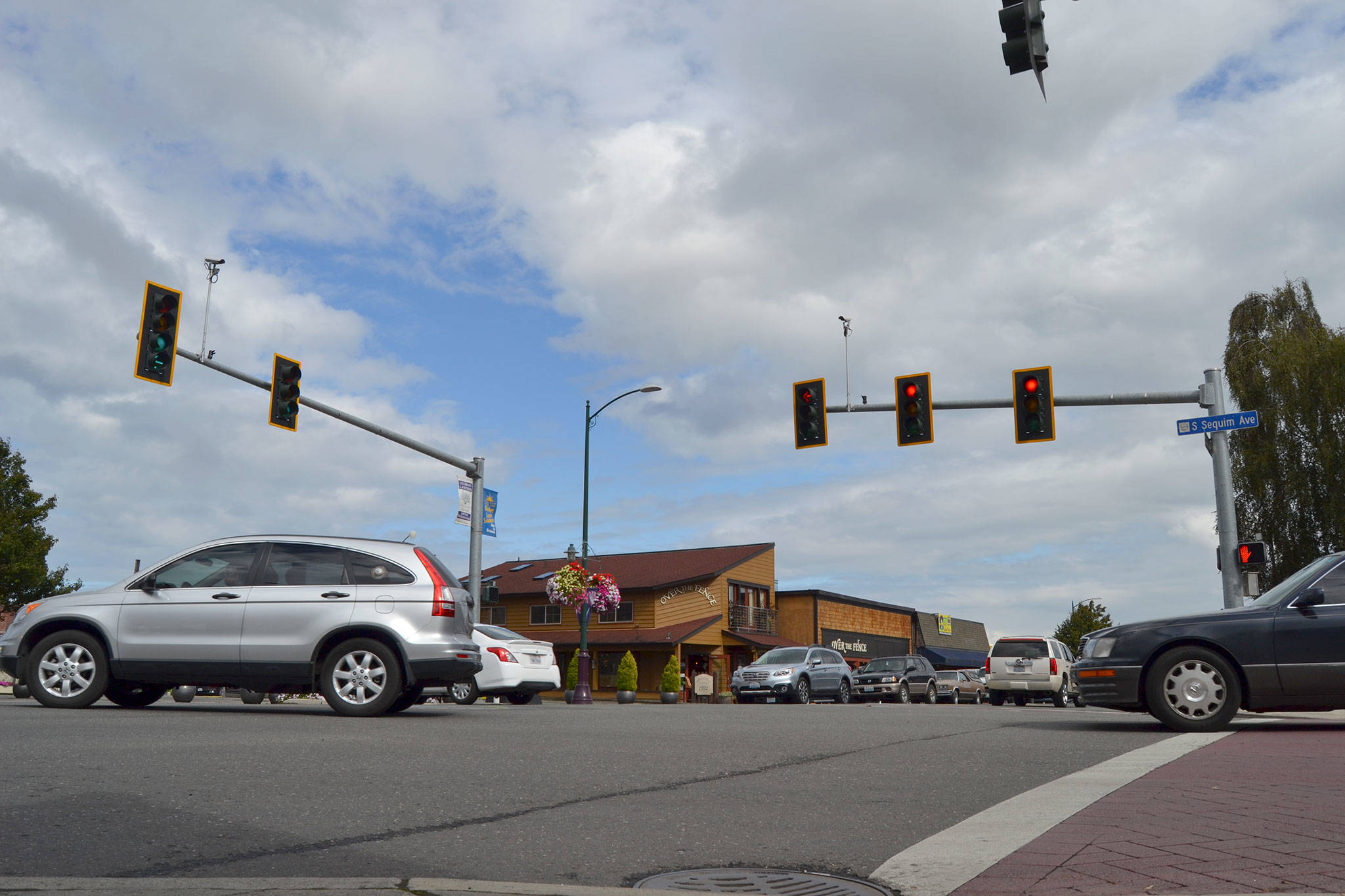SEQUIM — Sequim street congestion might be laughable to some from big cities, but to other locals in tourist season, driving along Washington Street can seem unbearable.
However, wait times at Sequim’s traffic signals for vehicles and pedestrians might be going down in the coming years.
Sequim city staff members said they are using a 2016 transportation study by Transportation Solutions, Inc. of Redmond to reduce east/west congestion, reduce pedestrian delays at traffic lights, add turn lanes and improve safety.
Sequim City Engineer Matt Klontz said at the Sept. 11 Sequim City Council meeting that the city’s first projects in the next year will cost $75,000 to $100,000 to install pedestrian countdown signs at Sequim Avenue/Washington Street, convert the left-turn lanes to include a flashing yellow, implement corridor-wide timing adjustments and repair a severed conduit for the signals.
City staff made public in the summer of 2016 that consultants learned the cable connecting Sequim Avenue/Washington Street’s traffic signal to lights to the west was severed unknowingly during a construction project and preventing the lights from syncing.
“The idea is that traffic could move through in a progression,” Klontz said.
Once projects are completed, city staff anticipates wait times at Sequim Avenue/Washington Street to decrease the most from an average delay of 49.2 seconds to 28.2 seconds.
The wait time at the intersection of Seventh Avenue/Washington Street is anticipated to decrease from 24.7 seconds to 20.9 seconds, Third Avenue/Washington Street by about 4 seconds and Fifth Avenue/Washington Street by about 2 seconds.
Klontz said adding flashing yellow lights for left-hand turns shortens the amount of time given for green arrows but allows drivers to go when there are gaps in oncoming traffic.
“With the Washington Street and Sequim Avenue intersection, we want to try to move more traffic onto Sequim in a shorter amount of time overall so that more eastbound/westbound time can be given to Washington Street,” Klontz said.
The consultant’s study said that traffic volumes have increased by 10 percent since 2012 and that the Sequim Avenue/Washington Street signal is operating at capacity while limiting traffic flow through the city.
Congestion is at its worst from 11:45 a.m. to 12:45 p.m., Klontz said, and midblock pedestrian crossings east and west of the Sequim Avenue/Washington Street intersection provide convenient crossings but increase vehicle congestion.
City Manager Charlie Bush said there are constraints with reducing vehicle traffic congestion in an established downtown area.
“To reroute traffic, you typically add lanes or things like that, but at the downtown intersection, the only way to do it is take real estate off corners and fundamentally change how a whole intersection looks,” he said.
Klontz said there aren’t many opportunities to add turn lanes at the existing traffic signals from Sequim Avenue to Seventh Avenue and they’re not sure that’s something city staff wants to add.
Typically cities the same size as Sequim formally update their timing plans every three to five years, Klontz said.
He’s not sure when the city formally did its last timing update but anticipates state Department of Transportation officials informally do it when they inspect each signal’s cabinet.
Along with this next year’s projects, city staff are tentatively planning more traffic light projects over 10 years.
In the next two to four years at a tentative cost of $300,000 to $500,000, Klontz said they are considering adding pedestrian countdown signals at the city’s other lights, converting other signals to include flashing yellow left-turn lights, adding right-turn pockets on Washington Street at Fifth and Seventh avenues, and realigning north/south left-turn lanes at Fifth and Seventh avenues.
Over five to 10 years at an estimated cost of $750,000 to $1 million, Klontz said they’d like to replace existing cables with fiber-optic cable, replace signal cabinets, add an adaptive traffic controller that reacts to real-time traffic and replace several Americans with Disabilities-compliant ramps and push buttons.
Klontz said they are waiting so long to replace the ramps and buttons because it requires a lot of tearing up roadway and time to complete while syncing with other upcoming projects.
“We’re going to leverage grant funds whenever we can,” Bush said.
Klontz said city staff’s goal is to eventually not have any vehicle or pedestrian wrecks at traffic lights while promoting a “sustainable Sequim” that helps eliminate emissions.
“The last thing we want to be known for is a traffic problem,” he said.
For more information on the traffic study, visit www.sequimwa.gov or call 360-683-4139.
________
Matthew Nash is a reporter with the Olympic Peninsula News Group, which is composed of Sound Publishing newspapers Peninsula Daily News, Sequim Gazette and Forks Forum. Reach him at mnash@sequimgazette.com.

